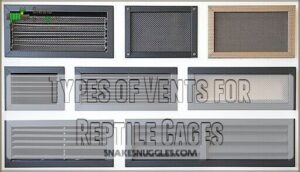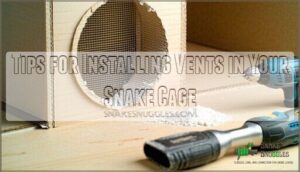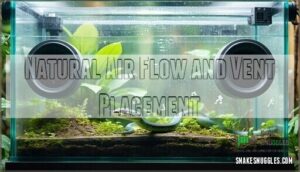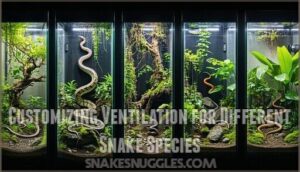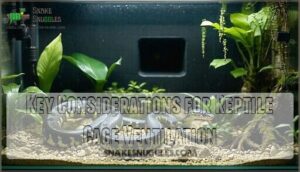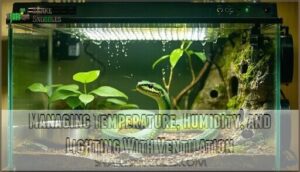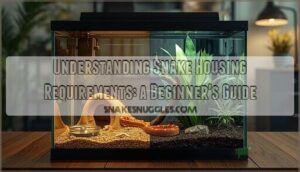This site is supported by our readers. We may earn a commission, at no cost to you, if you purchase through links.
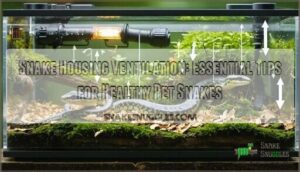 You’ll want to provide fresh air circulation without creating drafts that’ll stress your snake.
You’ll want to provide fresh air circulation without creating drafts that’ll stress your snake.
Proper snake housing ventilation prevents respiratory infections and maintains stable humidity levels your pet needs to thrive.
Most snakes require gentle airflow through vents placed at opposite ends of their enclosure—think of it like a natural breeze flowing through.
Cross-ventilation works best, with intake vents near the cool side and exhaust vents on the warm side, creating a subtle air current that removes stale air without disrupting temperature gradients.
Size your vents to about 1-2% of your enclosure’s floor space for ideal results.
Getting the airflow just right takes some fine-tuning based on your specific snake species and setup, requiring attention to stable humidity levels and gentle airflow to ensure your pet’s health and comfort, which is crucial for preventing stress and maintaining a healthy environment.
Table Of Contents
- Key Takeaways
- Reptile Cage Ventilation Basics
- Choosing The Right Vents for Your Snake Enclosure
- Snake Enclosure Ventilation Design
- Real-World Examples of Reptile Cage Ventilation
- Key Considerations for Reptile Cage Ventilation
- Snake Cage Essentials for Ventilation
- Managing Temperature, Humidity, and Lighting With Ventilation
- Troubleshooting Common Ventilation Issues in Snake Cages
- Frequently Asked Questions (FAQs)
- Does a snake enclosure need ventilation?
- What not to put in a snake enclosure?
- What do you put at the bottom of a snake enclosure?
- Do snakes need breathing holes?
- Do snake enclosures need ventilation?
- How to ventilate a reptile enclosure?
- How do you vent a snake?
- Can snakes crawl through air vents?
- How often should I clean the vents in my snakes cage?
- Can I use a fan to improve ventilation in the enclosure?
- Conclusion
Key Takeaways
- Install cross-ventilation with vents at opposite ends – Place intake vents on the cool side and exhaust vents on the warm side to create gentle airflow that removes stale air without disrupting temperature gradients or stressing your snake.
- Size your vents properly for optimal airflow – Use vents that equal 1-2% of your enclosure’s floor space and aim for 4-8 air changes per hour to prevent respiratory infections while maintaining stable humidity levels.
- Avoid direct drafts that can harm your snake – Position vents strategically so they don’t create direct airflow over your pet, which can cause stress and respiratory issues, while still maintaining proper air circulation.
- Monitor your snake’s behavior as a ventilation indicator – Watch for signs like mucus buildup, lethargy, or condensation issues that signal poor ventilation, and adjust your system accordingly to keep your snake healthy and comfortable.
Reptile Cage Ventilation Basics
Your snake’s health depends on proper airflow just as much as the right temperature and humidity.
Without adequate ventilation, your pet faces serious risks like respiratory infections, mold growth, and poor air quality that can quickly turn a comfortable home into a health hazard.
Why Ventilation is Important for Snakes
Your snake’s health depends on proper ventilation—it’s that simple.
Without fresh air circulation, your pet faces serious risks that can turn deadly fast.
1. Respiratory Health: Fresh air prevents pneumonia and other lung infections that kill snakes
2. Mold Prevention: Good airflow stops dangerous fungal growth in humid enclosures
3. Air Quality: Clean oxygen keeps your snake alert and active instead of lethargic
4. Temperature Regulation: Proper ventilation helps maintain healthy heat gradients throughout the habitat
Snake enclosure ventilation isn’t just nice to have—it’s essential for overall wellbeing.
Recommended Ventilation Rates for Snakes
Now that you understand ventilation’s importance, let’s talk numbers. Most snake enclosures need 6-12 square inches of total vent area for proper air exchange.
Your snake’s metabolic rate and enclosure size determine exact requirements, but 4-8 air changes per hour keeps most species healthy.
Proper ventilation is also essential for minimizing odors and maintaining healthy air quality.
| Enclosure Size | Recommended Vents | Air Changes/Hour |
|---|---|---|
| 40-gallon tank | 1-2 small vents | 4-6 |
| 4-foot PVC cage | 2-3 (5"x3") vents | 6-8 |
| Large custom builds | Multiple placement zones | 8-12 |
| Rainforest setups | 2% of wall surface | Variable |
Climate impact matters too—humid environments need less ventilation than dry ones to maintain proper snake health.
Factors Affecting Ventilation Needs
Several factors determine how much ventilation your snake needs. Species size plays a major role – larger snakes generate more heat and require better airflow. Your snake’s activity level also matters; active species need more oxygen exchange than sedentary ones.
Enclosure material affects ventilation requirements too. Glass and plastic cages retain heat, so you’ll need fewer vents. Mesh enclosures breathe naturally but may need extra airflow assistance.
Ambient conditions in your home impact snake enclosure ventilation. Warmer rooms need increased airflow to prevent overheating, while cooler spaces require balanced ventilation that doesn’t compromise heating.
Snake health depends on matching ventilation to humidity needs and cage size – getting this balance right keeps your pet comfortable year-round.
Choosing The Right Vents for Your Snake Enclosure
You’ll need to select the right vents to guarantee your snake stays healthy and comfortable in its enclosure.
The type, size, and placement of vents can make the difference between a thriving pet and one struggling with respiratory issues, which is why choosing the right vents is crucial for your snake’s health.
Types of Vents for Reptile Cages
When setting up snake enclosure ventilation, you’ll find several vent options that work well.
Mesh Vents offer excellent airflow and are perfect for DIY projects – just cut a hole and secure them with screws. Screened Vents prevent escapes while maintaining air circulation.
Louvered Vents provide directional airflow control, though they’re pricier. Baffled Vents reduce drafts while guaranteeing proper reptile habitat airflow.
You can buy pre-made options or create DIY Vents using hardware store materials for custom terrarium ventilation setup.
Insufficient airflow can lead to moisture buildup, so make certain you have lower ventilation grids for proper air circulation.
Vent Size and Placement Considerations
Getting vent location and hole size right can make or break your snake’s health – it’s like designing the perfect HVAC system for your scaly friend.
Cage size directly determines your ventilation needs. Larger enclosures require more vents to maintain proper airflow patterns. You’ll want to calculate roughly one square inch of ventilation per square foot of floor space.
Strategic placement creates natural air circulation. Position lower vents at the cool end and higher vents at the warm end – this encourages air to flow naturally upward as it heats.
Species needs vary dramatically. Ball pythons need different humidity than corn snakes, so research your specific snake’s requirements.
Here’s what matters most for snake enclosure ventilation:
- Draft prevention – avoid placing vents where they’ll create direct airflow over your snake
- Hole size should be small enough to prevent escapes but large enough for adequate snake ventilation
- Ventilation types include mesh screens, drilled holes, or adjustable vents for fine-tuning airflow. Knowing the appropriate reptile vent dimensions is essential for safety.
Tips for Installing Vents in Your Snake Cage
Installing vents in your snake enclosure doesn’t have to be intimidating. With proper tool selection and placement strategy, you’ll create excellent snake ventilation.
Position vents at opposite ends to establish natural airflow patterns. Choose spots your snake can’t block or damage during exploration.
Proper ventilation requires suitable enclosure hardware.
| Essential Tools | Smart Placement |
|---|---|
| Drill, jigsaw, sandpaper for clean cuts | Accessible locations for easy maintenance |
Select appropriate vent materials like mesh screens for security. When doing DIY venting, seal edges properly to prevent escapes.
Mark your drilling spots carefully before cutting. Sand rough edges smooth to avoid injuries. Test-fit vents before final installation.
Your snake cage setup will benefit from this thoughtful ventilation approach, creating a healthier environment for your pet, with proper ventilation and easy maintenance.
Snake Enclosure Ventilation Design
Creating an effective ventilation system for your snake’s enclosure requires careful planning to guarantee proper airflow without compromising your pet’s comfort.
You’ll need to balance natural air circulation with temperature control while considering your specific snake species’ unique environmental needs, ensuring a system that supports both the health and comfort of your pet.
Natural Air Flow and Vent Placement
Position your vents at opposite ends of the cage to master cross ventilation and natural airflow.
This strategic placement creates a gentle breeze that keeps air moving without creating harsh drafts.
For stacked cages, alternate vent location between levels.
Screen tops work great with side vents for ideal air circulation in your snake enclosure ventilation system.
Avoiding Drafts and Heat Loss
Your snake’s comfort depends on avoiding drafts that can trigger respiratory infections.
Place vents strategically away from heat sources to prevent unwanted heat loss while maintaining proper snake enclosure ventilation.
Smart vent baffling redirects airflow without creating direct drafts on your pet.
Choose cage material like glass or plastic that retains ambient temperature better than metal.
Effective insulation methods and careful heat source placement preserve temperature gradients essential for thermoregulation.
Customizing Ventilation for Different Snake Species
Different snake species need custom ventilation solutions to thrive in captivity. Species-Specific Needs vary dramatically between arboreal and terrestrial snakes, making habitat mimicry essential for snake health.
- Arboreal species like Green Tree Pythons require Arboreal Ventilation with mesh sides and vertical airflow to maintain 70-90% humidity without stagnant air pockets.
- Desert dwellers such as Rosy Boas need open ventilation systems that prevent moisture buildup while maintaining their preferred 20-40% humidity range.
- Tropical species demand controlled airflow that balances fresh air exchange with Humidity Requirements between 50-90% depending on their natural habitat.
- Terrestrial snakes like Corn Snakes thrive with moderate cross-ventilation using upper and lower vents that facilitate natural convection patterns.
Your snake enclosure ventilation should mirror their wild environment for ideal snake enclosure health.
Real-World Examples of Reptile Cage Ventilation
You’ll find that real-world snake enclosures come in all shapes and sizes, each requiring a unique approach to ventilation.
Whether you’re housing a small corn snake or managing a rack system with dozens of pythons, these practical examples will show you exactly how to keep your scaly friends breathing easy.
Ventilation for Small Snake Cages
When you’re setting up small snake cages, proper snake tank air circulation becomes your top priority.
Hatchling ventilation requires gentle airflow without creating drafts that could stress your young snake.
| Cage Size | Vent Configuration | Cleaning Frequency |
|---|---|---|
| 10-20 gallon | 4-6 DIY micro-vents | Weekly |
| 20-30 gallon | 6-8 small vents | Bi-weekly |
| 30-40 gallon | 8-10 vents | Bi-weekly |
| Plastic tubs | 4-6 holes + mesh | Weekly |
| Glass tanks | Side + top vents | Monthly |
Space optimization matters when installing snake enclosure ventilation.
Place three small vents on opposite sides, ensuring cross-ventilation without compromising escape prevention.
Your snake vivarium ventilation should maintain humidity while preventing stagnant air that leads to respiratory issues.
Ventilation for Large Snake Cages
Large snake enclosure ventilation demands bigger solutions than smaller setups. You’ll need blower systems or multiple vents to move air through spacious vivariums effectively.
Material choice matters too – DIY ventilation with metal mesh works better than plastic for large snake cages. Automated control systems help maintain consistent snake tank air circulation without constant adjustments.
- Install 4-6 vents strategically: two high, two low, with additional side vents for cross-flow
- Consider computer fans for active airflow in cages over 75 gallons
- Use cage size calculations: one 4"x6" vent per 40 gallons of enclosure volume
Unique Ventilation Solutions for Stacked Cages
Building on large cage ventilation, stacked cages present unique challenges that require creative solutions.
Your vertical setup can become a snake health nightmare without proper planning, but these three approaches will keep your collection thriving:
- Vertical airflow systems – Install fans that pull air from bottom to top, creating natural convection currents through each level while maintaining individual control over each enclosure’s environment.
- Shared ventilation networks – Design internal air ducts behind cage backgrounds that distribute fresh air to multiple units while incorporating safety measures like escape-proof mesh screens.
- Individual climate zones – Use adjustable vents with aesthetic integration, allowing you to fine-tune each cage’s air flow without compromising the overall setup’s appearance or your snakes’ comfort.
Key Considerations for Reptile Cage Ventilation
When you’re planning your snake’s ventilation system, you need to take into account how their unique metabolism affects their air quality needs.
Unlike mammals, snakes generate less heat and produce carbon dioxide at different rates, which means you can’t just copy ventilation setups from other pets, as this would not account for the unique aspects of a snake’s metabolism and the resulting impact on their air quality needs.
Reptile Metabolism and Ventilation Needs
Your snake’s metabolic rate directly affects its ventilation needs.
While snakes have lower oxygen consumption than mammals, they still require proper airflow during digestion and activity periods.
Temperature impact and humidity effects vary by species variation – ball pythons need different reptile enclosure air quality than corn snakes.
| Activity Level | Oxygen Needs | Ventilation Required |
|---|---|---|
| Resting | Low | Baseline airflow |
| Digesting | High | Increased ventilation |
| Active/Shedding | Moderate | Enhanced air exchange |
| Breeding Season | Variable | Species-specific needs |
Understanding reptile metabolism helps you design better snake health ventilation systems for ideal proper reptile ventilation.
Regular monitoring using digital hygrometers is essential for maintaining proper humidity.
Balancing Heat Generation and Ventilation
Understanding reptile metabolism sets the stage for mastering heat and ventilation balance. You’ll need to maintain warmth while guaranteeing fresh air circulation—think of it as creating a cozy room with an open window.
Strategic Heat Source Placement keeps your snake comfortable without fighting airflow. Position heat lamps outside screened tops, allowing radiant warmth while permitting air exchange. Thermostat Integration prevents overheating when ventilation increases cooling effects.
Species Temperature Needs vary substantially—ball pythons need different conditions than corn snakes. Seasonal Adjustments help maintain consistent environments year-round, while Insulation Strategies around heating elements preserve energy efficiency.
Consider these snake enclosure ventilation principles for ideal temperature control:
- Position heating elements to work with airflow patterns, not against them
- Use multiple smaller heat sources rather than one large source for better distribution
- Install adjustable vents near heat sources to fine-tune temperature gradients
- Monitor both ambient and surface temperatures to guarantee proper reptile enclosure ventilation
Maintaining Air Quality and Humidity
Your snake’s air quality monitoring starts with watching for clear eyes and steady breathing.
Design a humidity gradient from 40-70% using substrate moisture balance—avoid overly wet bedding that breeds bacteria.
Ventilation system cleaning every month keeps airflow fresh, while seasonal adjustments help maintain ideal snake respiratory health year-round.
Snake Cage Essentials for Ventilation
Setting up your snake’s cage properly creates the foundation for effective ventilation that keeps your pet healthy and comfortable.
You’ll need to take into account how cage size, bedding materials, and decorative elements work together to promote good airflow while maintaining the right temperature and humidity levels, which is crucial for the overall health and comfort of your pet.
Cage Size and Ventilation Requirements
Your snake’s comfort depends on matching cage size to ventilation rates. Think of it like choosing the right room for a house party – too small and everyone’s gasping for air, too big and the atmosphere gets cold and drafty.
Species Size directly impacts Enclosure Volume requirements. Ball pythons need different Airflow Patterns than corn snakes because their Metabolic Rate varies substantially.
Here’s your snake enclosure size guidelines:
- Small snakes (under 3 feet): 20-40 gallon tanks with moderate ventilation rates
- Medium snakes (3-6 feet): 40-75 gallon enclosures requiring enhanced airflow
- Large snakes (6+ feet): Custom enclosures with proportional snake enclosure ventilation
- Active species: Need 25% more space than sedentary snakes
- Arboreal snakes: Require taller cages with vertical air circulation
Cage Materials affect ventilation efficiency. Glass tanks need more vents than wooden enclosures because they trap moisture differently. Your snake size determines baseline requirements, but remember – bigger cages need proportionally more ventilation to maintain proper air exchange throughout the entire snake enclosure.
Materials and Bedding for Ventilation
Beyond cage size, your snake enclosure materials and bedding choices directly impact substrate airflow and ventilation efficiency.
Choose mold resistance options like cypress mulch or coconut husk for humidity retention, while aspen shavings work great for drier setups.
Avoid material toxicity risks—skip cedar shavings and sand.
Paper towels offer cleaning ease but don’t support natural airflow like loose substrates do.
Proper ventilation is key, so consider snake bedding options to maintain a healthy environment.
Enrichment and Hiding Places for Ventilation
Strategic enrichment placement transforms your snake enclosure ventilation from basic to brilliant. When you arrange hiding spots and climbing branches thoughtfully, you’re creating natural airflow channels that boost air circulation while keeping your snake comfortable.
- Hide boxes with ventilation gaps – Position openings to encourage airflow without sacrificing security
- Climbing branch airflow – Arrange branches to guide air movement through different cage levels
- Water bowl placement – Strategic positioning enhances humidity control and air mixing
- Substrate ventilation impact – Choose materials that won’t block airflow around enrichment items
- Plant ventilation effects – Live or artificial plants can direct airflow when placed correctly
- Multiple hiding places – Create air corridors between different retreat options for ideal circulation
Managing Temperature, Humidity, and Lighting With Ventilation
Creating the perfect snake habitat means balancing temperature, humidity, and lighting with proper ventilation—it’s like conducting an orchestra where every element must work in harmony.
When you get this balance right, your snake will thrive in an environment that mimics their natural habitat while preventing common health issues, and this balance is crucial for the snake’s overall well-being, making ventilation a key factor.
Temperature Gradients and Ventilation
Creating the perfect temperature gradient in your snake enclosure means balancing heat sources with smart ventilation.
Position your basking spot at one end while maintaining cool zones at the opposite side.
This gradient creation requires careful airflow management—too much ventilation near heat sources can disrupt your temperature zones.
Use thermostat control to maintain consistent temperatures while ensuring snake enclosure ventilation doesn’t create drafts.
Strategic vent placement allows natural airflow without compromising your carefully crafted temperature gradient, keeping your snake comfortable and healthy.
Humidity Control and Ventilation
Balancing snake enclosure humidity with proper ventilation keeps your pet healthy and happy.
Different species need specific humidity levels—tropical snakes thrive at 70-90% while desert species prefer 20-40%. Smart airflow management prevents respiratory issues without sacrificing moisture control.
- Misting systems provide consistent humidity while maintaining fresh air circulation
- Substrate choice like cypress mulch retains moisture better than paper towels
- Humidity gradients mimic natural habitats by creating varying moisture zones
- Seasonal adjustments help accommodate changing environmental conditions and altitude effects
Lighting and Ventilation Considerations
When managing both lighting and snake enclosure ventilation, you’ll want to position your heat lamps outside the cage with proper screening to maintain fresh air circulation.
UVB lights support calcium metabolism while creating essential basking spots for your snake’s diurnal cycle.
Here’s how light placement affects airflow and heat balance:
| Light Type | Placement Strategy | Ventilation Impact |
|---|---|---|
| Heat Lamps | Outside cage, screened top | Prevents overheating, maintains airflow |
| UVB Lights | Above basking area | Creates temperature gradient safely |
| Combined Setup | Coordinated positioning | Balances heat without blocking fresh air |
Smart light placement guarantees your snake enclosure maintains prime airflow while providing necessary heat and UVB impact for snake health.
Troubleshooting Common Ventilation Issues in Snake Cages
Even the best ventilation setups can hit snags, leaving your snake dealing with stale air, funky odors, or respiratory issues that’ll have you scratching your head.
Spotting these problems early and knowing how to fix them can save you from expensive vet bills and keep your scaly friend breathing easy.
This approach will help you save from potential issues and ensure the well-being of your pet.
Recognizing Ventilation Problems in Snakes
Your snake’s behavior often tells the story before anything else does.
Looking at this passage about snake behavior and ventilation, here’s an engaging blockquote that captures the same tone:
Your snake’s body language speaks volumes before problems become visible.
Watch for these telltale signs of poor ventilation that can lead to serious respiratory infections:
- Mucus Buildup around the nose, mouth, or eyes
- Lethargy Signs like reduced activity and appetite loss
- Condensation Issues creating foggy glass or water droplets
You’ll also notice Odor Buildup from stagnant air or Draft Detection through uneven temperatures.
Maintaining proper airflow also helps prevent mold and bacteria growth.
These warning signals indicate your snake enclosure ventilation isn’t working properly, putting your pet at risk for health problems.
Solutions for Poor Air Quality and Ventilation
When poor ventilation strikes your snake’s home, quick action prevents serious health issues.
Clean blocked vents, add activated carbon filters, and consider air purifiers for stubborn odors.
DIY solutions like computer fans boost airflow effectively.
| Problem | Quick Fix | Long-term Solution |
|---|---|---|
| Mold growth | Remove affected substrate | Install exhaust fans |
| Respiratory infections | Increase air exchange | Add cross-ventilation |
| Stagnant air | Position small fan nearby | Redesign vent placement |
Monitor humidity control closely—ozone concerns make some air purifiers unsuitable for snake enclosure ventilation.
Address poor ventilation before it escalates into costly vet bills.
Frequently Asked Questions (FAQs)
Does a snake enclosure need ventilation?
Testing the theory that snakes don’t need ventilation reveals a dangerous misconception.
Your snake absolutely requires proper airflow to prevent respiratory infections, mold growth, and maintain healthy air quality that mimics its natural habitat, ensuring a healthy environment.
What not to put in a snake enclosure?
Avoid toxic substrates like cedar shavings, sand, gravel, wood shavings, corncob, walnut shells, and cat litter. Don’t use materials that can cause impaction or respiratory issues in your snake.
What do you put at the bottom of a snake enclosure?
You’ll want to use newspaper, butcher paper, reptile carpet, or paper towels as substrate.
These materials are safe, easy to clean, and provide good traction for your snake while avoiding toxic options.
Do snakes need breathing holes?
Yes, snakes absolutely need proper ventilation in their enclosures.
You’ll want to install breathing holes or vents to prevent respiratory infections, reduce mold growth, and maintain healthy air quality for your snake’s well-being.
Do snake enclosures need ventilation?
Snake enclosures absolutely need proper ventilation to prevent respiratory infections, control humidity, and maintain fresh air.
You’ll want cross-ventilation with vents at opposite ends, avoiding drafts that could chill your snake.
How to ventilate a reptile enclosure?
Install vents at opposite ends of your enclosure to create cross-ventilation. Use wire mesh or adjustable vents, placing them strategically to avoid drafts while maintaining proper airflow and temperature gradients.
How do you vent a snake?
Like medieval castle builders knew, proper airflow prevents disease! You’ll need ventilation holes on opposite ends of your snake’s enclosure to create cross-ventilation, preventing respiratory infections and mold growth.
Can snakes crawl through air vents?
Most snakes can’t squeeze through standard home air vents due to their body size.
However, smaller species like baby snakes or garter snakes might access larger residential vents if gaps exist around the vent covers or ductwork connections.
How often should I clean the vents in my snakes cage?
You’ll want to clean your snake’s enclosure vents every 4-6 weeks to prevent blockages and maintain proper airflow.
Regular cleaning prevents dust buildup that could restrict ventilation and compromise your snake’s health.
Can I use a fan to improve ventilation in the enclosure?
Yes, you can use a fan to improve airflow in your snake’s enclosure, but make certain it doesn’t create direct drafts that could stress your snake or cause temperature fluctuations.
Conclusion
Getting your snake housing ventilation right isn’t rocket science, but it’s the foundation of reptile health.
You’ve learned that proper airflow prevents respiratory infections while maintaining stable humidity levels.
Cross-ventilation with intake vents on the cool side and exhaust vents on the warm side creates gentle air currents without stressing your snake.
Remember, vent sizing should equal 1-2% of floor space for ideal results.
Monitor your snake’s behavior and adjust ventilation as needed—healthy snakes show you’re doing it right.
- https://talis-us.com/blogs/news/essential-features-of-snake-enclosures
- https://www.youtube.com/watch?v=kBYGzEY-uUQ
- https://www.reptile-cage-plans.com/emails/howmuchventilation.html
- https://www.reddit.com/r/snakes/comments/7mhsvp/ventilation_for_custom_enclosure/
- https://www.aussiepythons.com/threads/diy-snake-enclosure-help-would-this-be-enough-air-ventilation.175070/

